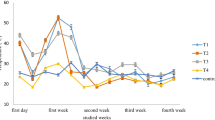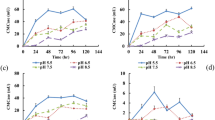Abstract
Rice straw biogas residue contains high lignin content, so the decomposition of this material by natural compost is slow. This study investigated the effect of the combination of rice straw addition and microbial inoculation (Aspergillus niger CICIMF0410 and Phanerochaete chrysosporium AF96007) on the physiochemical properties of rice straw biogas residue in the composting process. Four composting treatment groups were designed: rice straw biogas residue (RR; T1), RR + rice straw (RS) (T2), RR + inoculants (T3), and RR + RS + inoculants (T4). The addition of rice straw significantly accelerated the initial temperature rise during composting, and microbial inoculation accelerated lignocellulose decomposition. After composting, the electrical conductivities of samples T1 to T4 were 1.22, 0.87, 0.99, and 0.82 DS ml−1, respectively. Compared with other treatment samples, T4 showed noticeably increased degradation rates of HC, CL, and ADL after decomposition. The total humic acid levels of samples T1 to T4 were 9.5, 12.7, 10.5, and 18.6%, with humification index values of 1.45, 1.80, 1.69, and 2.46, respectively, after maturation. After 12 weeks of composting, T4 showed the highest increase in total nitrogen (37.6%), phosphorus (33.6%), and potassium (29.8%) levels. Furthermore, compared with other treatment samples, T4 showed the best maturity indices, such as morphology, color, and odor. Rice straw addition and biological inoculation for biogas residue composting not only significantly decreases the time required for decomposition but also eliminates the toxicity risk for crops and improves the stability of the biogas residue fertilizer.




Similar content being viewed by others
References
Baetge S, Kaltschmitt M (2018) Rice straw and rice husks as energy sources—comparison of direct combustion and biogas production. Biomass Convers Bior 03:719–737
Meng XY, Liu B, Zhang H, Wu JW, Yuan XF, Cui ZJ (2019) Co-composting of the biogas residues and spent mushroom substrate: physicochemical properties and maturity assessment. Bioresour Technol 276:281–287
Tsachidou B, Scheuren M, Gennen J et al (2019) Biogas residues in substitution for chemical fertilizers: a comparative study on a grassland in the Walloon Region. Sci Total Environ 666:212–225
Odlare M, Abubaker J, Lindmark J, Pell M, Thorin E, Nehrenheim E (2012) Emissions of N2O and CH4 from agricultural soils amended with two types of biogas residues. Biomass Bioenergy 44:112–116
Zhu LJ, Zhao Y, Zhang WS et al (2019) Roles of bacterial community in the transformation of organic nitrogen toward enhanced bioavailability during composting with different wastes. Bioresour Technol 267:378–385
Sánchez ÓJ, Ospina DA, Montoya S (2017) Compost supplementation with nutrients and microorganisms in composting process. Waste Manag 69:136–153
Duan YM, Kumar SK, Awasthi MK et al (2019) Evaluating the impact of bamboo biochar on the fungal community succession during chicken manure composting. Bioresour Technol 272:308–314
Wu JQ, Zhao Y, Yu HM et al (2019) Effects of aeration rates on the structural changes in humic substance during co-composting of digestates and chicken manure. Sci Total Environ 658:510–520
Tsapekos P, Alvarado-Morales M, Panagiotis G et al (2019) Enhancing anaerobic digestion of agricultural residues by microaerobic conditions. Biomass Convers Bior 05:1–9
Qian XY, Shen GX, Wang ZQ, Guo C, Liu Y, Lei Z, Zhang Z (2014) Co-composting of livestock manure with rice straw: characterization and establishment of maturity evaluation system. Waste Manag 34:530–535
Casini D, Barsali T, Rizzo AM (2019) Production and characterization of co-composted biochar and digestate from biomass anaerobic digestion. Biomass Convers Bior 07:1–9
Qiao XL, Zhao C, Shao QJ et al (2017) Application of hydrogen peroxide presoaking prior to ammonia fiber expansion pretreatment of energy crops. Fuel 205:184–191
Conrad M, Häring H, Smirnova I (2019) Design of an industrial autohydrolysis pretreatment plant for annual lignocellulose. Biomass Convers Bior 07:1–18
Nielsen F, Galbe M, Zacchi G et al (2019) The effect of mixed agricultural feedstocks on steam pretreatment, enzymatic hydrolysis, and cofermentation in the lignocellulose-to-ethanol process. Biomass Convers Bior 06:1–14
Li B, Chen KJ, Zhao C et al (2015) Influence of steam explosion on rice straw fiber content. J Biobased Mater Bio 9:596–608
Xu R, Zhang K, Liu P et al (2018) Lignin depolymerization and utilization by bacteria. Bioresour Technol 269:557–566
Gou CL, Wang YQ, Zhang XQ, Lou YJ, Gao YH (2017) Inoculation with a psychrotrophic-thermophilic complex microbial agent accelerates onset and promotes maturity of dairy manure-rice straw composting under cold climate conditions. Bioresour Technol 243:339–346
Hastrup ACS, Howell C, Larsen FH, Sathitsuksanoh N, Goodell B, Jellison J (2012) Differences in crystalline cellulose modification due to degradation by brown and white rot fungi. Fungal Biol 116:1052–1063
Asina F, Brzonova I, Voeller K, Kozliak E, Kubátová A, Yao B, Ji Y (2016) Biodegradation of lignin by fungi, bacteria and laccases. Bioresour Technol 220:414–424
Wu J, Zhao Y, Qi HS et al (2017) Identifying the key factors that affect the formation of humic substance during different materials composting. Bioresour Technol 244:1193–1196
Steinbach D, Kruse A, Sauer J (2017) Pretreatment technologies of lignocellulosic biomass in water in view of furfural and 5-hydroxymethylfurfural production—a review. Biomass Convers Bior 02:247–274
Jiang JS, Kang K, Chen D, Liu NN (2018) Impacts of delayed addition of N-rich and acidic substrates on nitrogen loss and compost quality during pig manure composting. Waste Manag 72:161–167
Sari GL, Trihadiningrum Y, Wulandar DAI, Pandebesie ES, Warmadewanthi IDAA (2018) Compost humic acid-like isolates from composting process as bio-based surfactant: properties and feasibility to solubilize hydrocarbon from crude. J Environ Manag 225:356–363
Spaccini R, Cozzolino V, DiMeo V, Savy D, Drosos M, Piccolo A (2019) Bioactivity of humic substances and water extracts from compost made by ligno-cellulose wastes from biorefinery. Sci Total Environ 646:792–800
Salgado MMM, Blu RO, Janssens M, Fincheira P (2019) Grape pomace compost as a source of organic matter: evolution of quality parameters to evaluate maturity and stability. J Clean Prod 216:56–63
Ravindran B, Nguyen DD, Chaudhary DK et al (2019) Influence of biochar on physico-chemical and microbial community during swine manure composting process. J Environ Manag 232:592–599
Li X, Shi XS, Yang ZM, Xu XH, Guo RB (2019) Effects of recyclable ceramsite as the porous bulking agent during the continuous thermophilic composting of dairy manure. J Clean Prod 217:344–351
Rashad FM, Saleh WD, Moselhy MA (2010) Bioconversion of rice straw and certain agro-industrial wastes to amendments for organic farming systems: 1. Composting, quality, stability and maturity indices. Bioresour Technol 101:5952–5960
Wang XK, Zheng GD, Chen TB, Nie E, Wang Y, Shi X, Liu J (2019) Application of ceramsite and activated alumina balls as recyclable bulking agents for sludge composting. Chemosphere 218:42–51
Guo XX, Liu HT, Wu SB (2019) Humic substances developed during organic waste composting: formation mechanisms, structural properties, and agronomic functions. Sci Total Environ 262:501–510
Zeng GM, Yu M, Chen YN et al (2019) Effects of inoculation with Phanerochaete chrysosporium at various time points on enzyme activities during agricultural waste composting. Bioresour Technol 101:222–227
Zucconi F, Forte M, Monaco A, Bertoldi M (1981) Biological evaluation of compost maturity. Biocycle 22:27–29
Pérez LR, Martínez C, Marcilla P, Boluda R (2009) Composting rice straw with sewage sludge and compost effects on the soil–plant system. Chemosphere 75:781–787
Saludes R, Iwabuchi K, Miyatake F, Abe Y, Honda Y (2008) Characterization of dairy cattle manure/wallboard paper compost mixture. Bioresour Technol 99:7285–7290
Tran QNM, Mimoto H, Nakasaki K (2015) Inoculation of lactic acid bacterium accelerates organic matter degradation during composting. Int Biodeterior Biodegrad 104:377–383
Wang XQ, Cui HY, Shi JH, Zhao X, Zhao Y, Wei Z (2015) Relationship between bacterial diversity and environmental parameters during composting of different raw materials. Bioresour Technol 198:395–402
Yu HY, Xie BT, Khan R, Shen GM (2019) The changes in carbon, nitrogen components and humic substances during organic-inorganic aerobic co-composting. Bioresour Technol 271:228–235
Sharma D, Yadav KD, Kumar S (2018) Role of sawdust and cow dung on compost maturity during rotary drum composting of flower waste. Bioresour Technol 264:285–289
Zayed G, Abdel-Motaal H (2005) Bio-active composts from rice straw enriched with rock phosphate and their effect on the phosphorus nutrition and microbial community in rhizosphere of cowpea. Bioresour Technol 96:929–935
Malherbe S, Cloete TE (2002) Lignocellulose biodegradation: fundamentals and applications. Rev Environ Sci Bio 1:105–114
Keller P (1961) Methods to evaluate maturity of compost. Compost Sci Util 2:20–26
He XS, Yang C, You SH et al (2019) Redox properties of compost-derived organic matter and their association with polarity and molecular weight. Sci Total Environ 665:920–928
Tomati U, Galli E, Pasetti L, Volterra E (1995) Bioremediation of olive-mill wastewaters by composting. Waste Manag Res 13:509–518
Qi HS, Wei ZM, Zhang JM, Zhao Y, Wu J, Gao X, Liu Z, Li Y (2019) Effect of MnO2 on biotic and abiotic pathways of humic-like substance formation during composting of different raw materials. Waste Manag 87:326–334
Wu JQ, Zhao Y, Zhao W et al (2017) Effect of precursors combined with bacteria communities on the formation of humic substances during different materials composting. Bioresour Technol 226:191–199
Funding
This research was financially supported by the Zhejiang Natural Science Foundation (LQ17C130001), National Natural Science Foundation of China (31801317), School Research and Development Fund Project (2014FR046), and Student Research Training Project (101-2013200080).
Author information
Authors and Affiliations
Corresponding author
Ethics declarations
Competing interests
The authors declare that they have no competing interests.
Additional information
Publisher’s Note
Springer Nature remains neutral with regard to jurisdictional claims in published maps and institutional affiliations.
Rights and permissions
About this article
Cite this article
Du, X., Li, B., Chen, K. et al. Rice straw addition and biological inoculation promote the maturation of aerobic compost of rice straw biogas residue. Biomass Conv. Bioref. 11, 1885–1896 (2021). https://doi.org/10.1007/s13399-019-00587-y
Received:
Revised:
Accepted:
Published:
Issue Date:
DOI: https://doi.org/10.1007/s13399-019-00587-y




